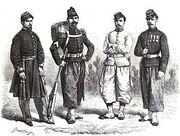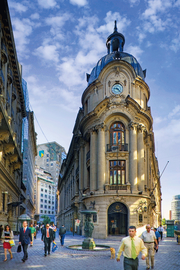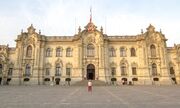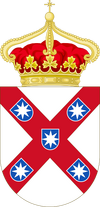| Kingdom of New Granada Reino da Nova Granada Timeline: Principia Moderni IV (Map Game)
OTL equivalent: Colombia | |||
|---|---|---|---|
1823 - 1918 Veralista Government | |||
|
|||
| Motto: Assim Sempre aos Tiranos Thus Always to Tyrants |
|||
| New Granada (1825) in mustard; claims in light mustard
|
|||
| Capital (and largest city) | Bogotá | ||
| Other cities | Medellín, Cáli, Barranquilla, Maracaibo, Cartagena | ||
| Official languages | Portuguese | ||
| Ethnic groups | White, mestizo, mulatto, black, indigenous | ||
| Religion | Roman Catholicism | ||
| Demonym | New Granadian (novagranadino) | ||
| Government | Constitutional Monarchy | ||
| - | Monarch | Miguel II Bragança | |
| - | Palestrante | Eduardo Graça | |
| Legislature | Cortes Gerais | ||
| History | |||
| - | Colony of Nova Lusitânia | 1xxx-1xxx | |
| - | Dominion of New Granada | 1790-1xxx | |
| - | Republic of New Granada | 1795-1805 | |
| - | Governate of Gran Panama | 1805-1823 | |
| - | Kingdom of New Granada | 1823-Present | |
| Population | |||
| - | 1870 census | 6.8 million | |
| Currency | New Granadian escudo (€) | ||
The Kingdom of New Granada (Portuguese: Reino da Nova Granada) is a northern Laurentian nation, bordered to the north by Aztlán, Burgundian Guyana to the east, Brésil to the southeast, and French Peru to the southwest.
The nation's history dates back to the pre-colonial period. Having only recently gained independence in 1823, New Granada is led by King Tomás I Bragança, who is also the pretender to the throne of Iberia, being the grandson of the last king deposed in the Bread Revolution.
History[]
Pre-Colonial Period[]
Caverna tribes (OTL Cueva tribe) to the northern region
Colonial Period[]
1521 - João Balboa, sent by Portugal's King Manuel to explore the New World; arrives in OTL Panama
1523 - Portuguese claims to OTL Panama established
1526 - Nova Lusitânia chartered; Portuguese Crown Merchant Company established
1529 - Immaculata from the Papal States arrive in Balboa Rocha, the capital of the colony
1532 - Edital de cana de açúcar, or The Sugar Cane Act, offers plots of land for cultivation of the sugar cane
1549 - Church of São Pedro completed, establishing second chartered city (after Balboa Rocha)
1556 - Raised from Apostolic Prefecture to Diocese of São Pedro
1577 - 1000 Burgundian men attack Nova Lusitânia repelled by 9000 Portuguese troops
1581 - Influx of Sevillian Christians
Subsequent era of benign neglect and notable expansion
1651 - Alongside other New World colonies, placed under a Viceroy
1653 - Revolt of Aquiminzaque, Maipure-Muisca Confederation
1772 - Treaty of Cartagena
1790 - Placed under dominion of New Granada
RULERS
Manuel I - 1521-1567
Sancho - 1567 - 1587
Henry II - 1587 -
Panama Wars[]
| Panama Wars (1804-1825) |
|---|
| First Panama War (1804) • Second Panama War (1816) • Third Panama War (1823-1825) |
First Panama War (1804)
Second Panama War (1816)
1821 - Appointment of Atílio Duarte de Alcantara as Governor of Gran Panama
Third Panama War (1823-1825); Treaty of Guadalajara ended Third Panama War in 1825
Teobaldo Candezón, the marshal
Independent Kingdom[]
1827 - Ratification of Constitution
1830 - First election
1832 - Second election
1837 - Third election
1842 - Fourth election
1844 - Fifth election
1849 - Sixth election
1850 - Seventh election
1852 - Death of Miguel I, ascension of Tomás
1855 - Eighth election/constitutional reform
1860 - Ninth election
1865 - Tenth election (victory for conservatives)

1870 Cortes Gerais
1870 - Eleventh election
1872 - Announcement of Belka and Burgundy to help build the Trans-Istmo Canal
1875 - Twelfth election
1880 - Thirteenth election; victory for conservative PdP
1885 - Fourteenth election
1890 - Fifteenth election
1895 - Sixteenth election
1900 - Seventeenth election
1905 - Eighteenth election
1901-1910[]
1911-1920[]
Occupation of the State of Amazons[]
Invasion of Hawaii[]
Since Miguel II ascended the throne of New Granada, Miguel had wished to establish an important naval base in the Pacific in order to expand New Granada's High Seas Fleet. In 1910, the Russian-Arabian War erupted and soon Miguel II took the opportunity to seize Hawaii as New Granada declared war on Hawaii in order to seize control of the Island. However, Miguel II's Plans were disrupted when the Belkan Empire sent it's East Asia Squadron in order to support New Granada as Hawaii was invaded throughout the year of 1913 and defeated. In order to secure Hawaii Miguel II sent diplomats to Manila in order to convince the Belkan Empire to let New Granada annex the Region. Unfortunately this backed fired as the Belkan Diplomats were not in the position to let Hawaii under the control of New Granada resulting in the diplomats being forced to let Hawaii be annexed by Belka. However during the Treaty of Lelystad which ended the Russian-Arabian War Hawaii became a joint protectorate of Belka and New Granada thus satisfying King Miguel II.
Laurentian Crisis[]
Participation in the Great War[]
In July 1914, the Cortes Gerais voted to declare war on New England due to New England's invasion Savannah who was an ally of New Granada as Foreign Minister Mateus Águas believed that it would be best for New Granada to respect it's alliance with Savannah. However, King Miguel II was opposed to this but was unable to get enough political and Military support in order to call in a withdrawal from the conflict. This promoted many Rightist Non-Inscrits, Liberals and Conservatives to form the Partido Popular Nacional. During the 1915 Elections the PPN led by Gabriel Siquera won the elections
Fascist Uprising and Civil War[]
Government[]
The Kingdom of New Granada is a constitutional monarchy, instituted by King Miguel and largely based upon his seminal Sentimentos do Homem no Novo Mundo, or Sentiments of Man in the New World. The King, as chief executive of New Granada, executes the laws passed by the Cortes Gerais, which possesses the legislative power of New Granada.
The elected leader of the Cortes is the Palestrante. According to the Constitution (1855 revision), elections are scheduled to be held every five years. Special elections may be called if the Palestrante is shown by a three-fifths vote to have violated the conditions of a working agreement between his party and independents backing the party, but such a threshold has yet to have been attained as of 1870.
Royal Family[]
The royal family in New Granada is the elder branch of the former Iberian House of Bragança. The first King of New Granada was Miguel, who was the eldest surviving son of the last king of Iberia. Miguel married ... and had three children: Tomás (18xx-present), Ernestina (18xx-present) and Inacio (18xx-present).
King Miguel was a well-respected statesman, who began forging international relations with a number of Laurentian and European powers. Miguel was also notable as a philosophic thinker and had a prominent role in the drafting of the New Granadian constitution. During his reign, which lasted from 1823 to 1852, he played an oversized role in the development of the nation's political character as a liberal constitutional monarchy.
Tomás ascended to the throne of New Granada in 1852. He had grown up in the shadow of his father, and knew that he would have to work with successive governments to maintain his family's grip on power. To that end, Tomás proposed an amendment to the constitution moving from unpredictable elections (with a five-year maximum) to regularly scheduled five-yearly elections.
Politics[]
New Granadian politics has traditionally been contested between liberal and conservative factions. This fault-line traces its roots back to the origin of each groupings' wealth. For example, the liberals tend to have earned an income through factories and trade, whereas the conservatives are more likely to lead a plantation-based lifestyle.
Ideologically, the liberals have a preference for industrialization, and modernization. The conservatives prefer the agrarian economy. A moderate poll tax remains in place for New Granadian eligible voters to qualify as electors, but not all members of political movements are electors.
There are a large number of não inscrito citizens who do not belong exclusively within either major grouping. These não inscritos range from worker collectives that pool resources to cast votes to an extremely wealthy capitalist class. Therefore, the não inscritos category is largely divided into the direito (Right) and esquerdo (Left). There are a small number of não inscritos who refuse to sit with either of the four major groupings; this group is known as the political centro (Center).
The Cortes Gerais is New Granada's unicameral legislature. It is comprised of 120 delegates, based on both provincial representation and population.
| Affiliation | Name | Delegates (1915) | |
|---|---|---|---|
| Não Inscritos: Esquerdo | Non-inscrits: Left | 4 | |
| Syndicalists | Grande Partido Sindicalista Panamá (GPSP) | 14 | |
| Liberals | Partido Urbano e Liberal — Miguelista (PUL—M) | 44 | |
| Não Inscritos: Centro | Non-inscrits: Center | 3 | |
| Conservatives | Partido do País (PdP) | 18 | |
| Ultranationalists | Partido Popular Nacional (PPN) | 35 | |
| Não Inscritos: Direito | Non-inscrits: Right | 3 | |
There is a small bureaucracy that implements the laws passed by the Cortes Gerais. This bureaucracy responds dually to the King and to the Deputy Palestrantes who oversee Committees of Origin in the Cortes.
Provinces[]
There are 12 provinces in the Kingdom of New Granada. They range from ... Each province is entitled to five seats in the Cortes Gerais, with the additional 60 seats being divided proportionately based on population as of the most recent census.
| Flag | Province | Capital | Population | Map |
Cortes Delegates |
|---|---|---|---|---|---|
| Amazónia | Mitú | 11th | 5+ | ||
| Ásdrubal | Cartagena | 5+ | |||
| Catatumbo | Maracaibo | 5+ | |||
| Cordilheira | Bogotá | 1st | 5+ | ||
| Costa Equatorial | Guaiaquil | 5+ | |||
| Ilhas Galápagos | Porto Maiorquino | 12th | 5+ | ||
| Istmo | Balboa Rocha | 5+ | |||
| 5+ | |||||
| 5+ | |||||
| 5+ | |||||
| 5+ | |||||
| 5+ |
Foreign Relations[]
In New Granada, foreign relations are determined on a national level in a bifurcated system wherein both the Cortes Gerais and the King can claim legitimacy over the area of policy. For example, the Constitution requires approval of a treaty by both the King and ratification by the Cortes Gerais. Therefore, it is not uncommon for the King and Palestrante (often through the Deputy Palestrante for Foreign Affairs) to enter separate negotiations with a foreign nation.
That being said, New Granada maintains strong diplomatic relations with a number of Laurentian, Arcadian and European nations. New Granada borders four nations: Aztlán, Burgundian Guyana, Brésil, and French Peru; of these four, there are strong relations with two and mediocre relations with the other two.
Since the declaration of independence in 1823 (and in reality, prior to that), New Granada's relations with Aztlán and its predecessor in the Mehican Empire have been tense. There is a lingering fear of the state that lies to the north, especially when nationalist tensions flare in Aztlán. New Granada also has an on-and-off relationship with Peru and generally supports an independent Peru rather than the French-dominated Union of Laurentia.
As for Burgundian Guyana and Brésil, relations are strong. Brésil is largely credited as a close friend of the New Granadian nation, due to its outsized influence in securing victory during the Third Panama War. Similar sentiments are felt towards Great Britain, who stepped in to stop the Mehicans from regaining New Granada in the 1820s.
Burgundy and Belka are both in a protective relationship with New Granada, and both are viewed favorably. This is the result of the 1872 decision by King Tomás and Palestrante Eduardo Graça to contract with those nations to construct the Trans-Istmo Canal. For 20 years after the construction of the canal, 15% of all trade fees and transport taxes are scheduled to be sent to Burgundy and Belka, who will split the income.
Relations with the republic in Iberia have been traditionally strained, due to the ousting of the last king of Iberia in the late 1700s. King Miguel I Bragança was the youngest son and eventual heir to the Iberian throne, and current New Granadian King Tomás maintains the pretender claim to the Iberian throne.
Military[]

Infantry of New Granada, circa 1870
The New Granadian military is largely a defensive force that protects the nation's homeland. The military is divided into three branches: Army, Navy, and Gendarmerie.
Army[]
The Army is itself divided into four primary divisions: the Infantry, the Cavalry, the Artillery, and Support. Each division carries out the functions traditionally associated with its mission. Notably, the Support Division is oftentimes
[]
The Navy of New Granada is a bi-oceanic force. However, the majority of the Navy is stationed along the Atlantic Ocean with a minority being located along the Pacific Coast.
Gendarmerie[]
The Gendarmerie is the national policing force of New Granada.
Economy[]
The economy of New Granada is heavily reliant upon the natural resources of the land. The nation has, however, recently entered into a relatively prosperous period since independence from first Iberia and then Mehico. This is due to the openness of foreign markets for exports, whereas under Iberia and later Mehico exports were greatly limited.
Industries that are among the most productive in New Granada are mining, agriculture and ranching, with some contributions by local merchants and artisans. From the late 1820s, Teobaldo Candezón - the nation's first Palestrante - introduced greater efforts at integrating the nations' internal trade. This was to counteract a historic division along regional lines. Candezón's goal was uma nação, um mercado, or "One Nation, One Market."
The wealth in New Granada is still heavily concentrated in the hands of white settlers rather than indigenous peoples or people of African descent. The demand for change of this system is relatively muted due to the lack of wholesale education among these groups, as well as...
"Socioeconomic changes proceeded slowly; the economic system functioned as a loosely related group of regional producers rather than as a national entity. Land and wealth were still the privileges of a minority. Forced labor continued in the mines, and various labor arrangements existed on the haciendas, such as sharecropping and low-wage labor. In each case, those owning the land benefited and those working the land remained impoverished.[3]"
Primary Sector[]
The economy of New Granada has traditionally been heavily reliant upon natural resources cultivation.
Secondary Sector[]
Trade and Currency[]

Laurentian Stock Exchange (BVL) Building
Trade is of vital importance to the New Granadian economy. Whereas many nations practice selective trade deals, New Granada has typically been open to trade from many different partner nations.
The currency of New Granada is the escudo (€). This currency is backed by a gold-standard. Individual banks, such as the Banco de Bogotá, issue paper money that serves to ease transfer of property and is redeemable into the corresponding amount of gold by the banks.
There is a small but burgeoning stock exchange located in Bogotá, where a number of local firms (including the five firms of the BVL Core) are listed.
Culture[]
Demographics[]
- 1820 census - 2.2 million
- 1870 census - 6.8 million
Art and Architecture[]

Plaza of Man's Government (Meeting place of Cortes Gerais)
Traditional New Granadian architecture dates back to the Iberian settlers of the
Music and Literature[]
Historically, New Granada has not been a major hub for either music or literature. Since independence, however, there has been an increased importance devoted towards these arts. [...]
As of the 1870s, the popular style of music in New Granada remains opera. The oldest and most ornate opera house in New Granada can be found in Cartagena, but a number of other cities boast their own theaters or music halls.
Education[]
There are two primary education tracks in New Granada. First is more prevalent in urban areas and among the wealthy plantation-owning class. This higher-quality education is known as instrução, and takes place primarily within a formal school setting (although tutors for the richer families is not yet unheard of). Pupils of the instrução begin at the age of five or six and continues for a decade until aged 16. They study a course that includes grammar, either Latin or Greek, literature, history, rhetoric, the sciences, and mathematics. After completing instrução, students are eligible to matriculate into university.
The second education track in New Granada is aprendizagem, which is more common among rural students and those in poor urban centers. Aprendizagem begins at the same age as instrução, but ends at the age of 14. Instead of a well-rounded focus in the classical liberal arts, aprendizagem includes basic grammar alongside some science. From the age of ten, a student enters into an apprenticeship which can take place on a neighbor's farm or in a factory. It is rare for a student who has completed aprendizagem to attend a university at the age of 16. As of 1874, the only university that will accept highly-qualified aprendizagem graduates is the Universidade Politécnica do Cartagena (Polytechnic University of Cartagena).
While standardized in a two-faceted manner as described above on a national level, the primary education scheme as a whole is largely managed by the various provinces. This means that school funding and deciding who enters instrução is left up to the provinces. In the Cortes Gerais, education is currently overseen by the Committee of Origin on Provincial Relations.
After primary education, those students who have completed instrução may pursue higher education at one of the New Granadian universities. These include:
- the Academia Militar Nacional at Maracaibo (National Military Academy);
- Faculdade das Ciências Sociais at Bogotá (Faculty of Social Sciences),
- Instituto de Medicina e Ciências da Vida in Medellín (Institute of Medicine and Life Sciences),
- and Academia de Engenharia (Engineering Academy) located in Cartagena.
In addition, there are a small number of polytechnic colleges across the nation.
Footnotes[]
To Do[]
- Page Development
- Government: Develop page on Palestrante
- Economy: Develop pages on Canal and escudo; finish Exchange companies
- History: Develop pages on Wars and flesh out home page history timeline
- Provinces: Finish map-making and naming
- National Development
- Continue to build infrastructure
- Don't forget about "one nation, one market"
| ||||||||||||||||||||||||||
| |||||||||||||||||||||||||||||||||||












